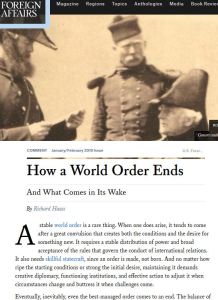Join getAbstract to access the summary!

Join getAbstract to access the summary!
Richard Haass
How a World Order Ends
And What Comes in Its Wake
Foreign Affairs, 2018
What's inside?
A new world order must reflect the 21st century’s realities and address its challenges.
Recommendation
World orders are rarely stable, nor are periods of relative peace a matter of coincidence, argues Richard Haass, one of America’s most insightful foreign policy thinkers. In his essay, Haass draws upon lessons from 19th century Europe to argue for a revised international order that is more inclusive and better able to deal with the challenges of the 21st century. His analysis of the state of the world today is sobering, yet anyone concerned about where the world is heading can take solace in his conclusion that it’s not too late to steer the world away from chaos.
Summary
About the Author
Richard Haass is president of the Council on Foreign Relations and served as a director of policy planning for the US State Department under President George W. Bush.




















Comment on this summary